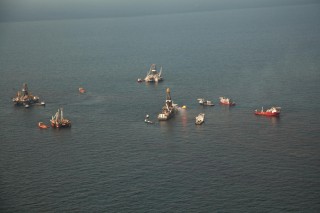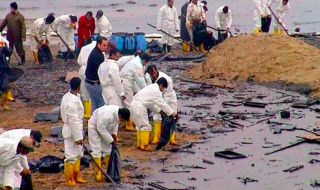
New Managing Director for Bellona Norway
The Board of the Bellona Foundation has appointed former Minister of Climate and the Environment Sveinung Rotevatn as Managing Director of Bellona No...
News

Publish date: January 15, 2015
News
NEW ORLEANS –Nearly five year after BP’s 4.9 million barrel oil spill the Gulf of Mexico, which it inundated with 2 million gallons of the cancer-causing chemical Corexit during clean up efforts, the US Environmental Protection Agency has proposed amendments to standards governing dispersant use in oil spills, the agency said earlier this week.
Numerous studies since the April 2010 Deepwater Horizon disaster have shown that the dispersants BP used on the spill — and especially the mix of oil and dispersants — was far more toxic to some organisms than anyone knew. Among them was a paper published in the peer-reviewed journal Environmental Pollution, which said the combination of Corexit and crude is 52 times more toxic than crude alone.
“During the Deepwater Horizon response, chemical dispersants were used without prior understanding of their impact on the health of the people and the animals that depend on the Gulf of Mexico,” said Marylee Orr, executive director of the Louisiana Environmental Action Network (LEAN). “Many of these impacts continue today.”

Isolating the specific toxins that have caused severe illnesses among ten of thousands of Gulf state residents, physicians and researchers say, is difficult because Nalco, the manufacturer of Corexit refuses to disclose the chemical’s ingredients, citing trade secrecy.
The United States holds the world’s largest stockpiles of the dispersant, which is banned in 18 countries, including Great Britain, home to BP.
Use of dispersants in oil spills has been required by the United States’ National Oil and Hazardous Substances Pollution Contingency Plan (NCP), which was adopted in 1968, Dr Riki Ott, one of America’s preeminent marine toxicologists and oil spill experts, and director of ALERT, told reporters in an internet conference call with reporters Wednesday.
Dr Susan Shaw, a professor of public health at the State University of New York, Albany’s department of environmental health studies, told Bellona during the call Wednesday, that “there is no safe exposure level” to Corexit.
“Use of Corexit in the Gulf was irreversibly destructive,” Shaw said, adding there was only one way to avoid future public health crises such as those the Gulf states are experiencing: “Don’t use dispersants.”
Shaw’s assertions are supported by the preponderance of evidence in dozen of studies that conclude the mixture of oil and dispersant is more easily absorbed by organisms, including humans, casting doubt on whether the supposed cure is more deadly than the disease.
EPA’s suggested changes
The EPA on Tuesday said its now ready to change some of its rules governing the use of dispersants, driven my lingering questions surrounding the Deepwater Horizon catastrophe.
“Our emergency officials need the best available science and safety information to make informed spill response decisions when evaluating the use of specific products on oil discharges,” Mathy Stanislaus, assistant administrator for the EPA’s Office of Solid Waste and Emergency Response, said in an EPA release.

“Our proposed amendments incorporate scientific advances and lessons learned from the application of spill-mitigating substances in response to oil discharges and will help ensure that the emergency planners and responders are well-equipped to protect human health and the environment,” he said.
The proposed changes detailed it the release include: New and revised product toxicity and efficacy test methodologies for dispersants, and other chemical and biological agents; New toxicity and efficacy criteria; Additional human health and safety information requirements from manufacturers; Revised area planning requirements for chemical and biological agent use authorization, and new dispersant monitoring requirements when used on certain oil discharges.
The EPA will be accepting public comments on the proposal for 90 days following publication in the Federal Register.
Too late?
Shanna Devine, the legislative coordinator for the Government Accountability Project (GAP), America’s preeminent whisteblower protection organization, presented grim health figures during the conference call that suggest the proposed EPA changes may be too little to late for the Gulf community’s health.
According to her group’s investigations, 100 percent of BP spill cleanup workers and others affected by the spill that submitted blood samples tested positive for high levels of chemicals found in Corexit and oil.

Further, independent air sampling by LEAN in the months following the spill found atmospheric concentrations of chemicals from dispersant and oil that exceeded levels at which physical health symptoms would be observed by 100 to 120 times.
Dr Robert Mathis, a physician from Santa Barbara, Californain, who studied health impacts from aerosolized Corexit and crude on the Gulf, told reporters that, “We really don’t know how far this stuff can travel.”
He said his responses to those with Corexit related distress stretched from the Gulf Coast to 240 kilometers inland, and said chemical plumes can travel as far as 2400 kilometers.
Devine went on to say that 70 percent of witnesses interviewed by GAP, who signed sword affidavits, said Corexit continued to be used after July 2010, when BP said it has stopped spraying the carcinogen.
These threats to public health, she told Bellona, went ignored. She also said that incidents of cancer reported to GAP in gulf communities have risen more steeply than levels reported by Bellona in August.
Ott: Gulf waters still hazardous
Ott told Bellona that recent studies indicate some 20,000 gallons of dispersant remain beached along the coasts of Gulf states.
Further evidence of remaining hazards from the BP’s heavy use of Corexit are the huge die-off of Dolphins affected by lung disease, hormonal abnormalities, and other health effects that were observed in 2013 and 2014 in the Gulf of Mexico, said Dr. Susan Shaw, founder and president of the Marine and Environmental Research Institute and School of Public Health at the State University of New York, Albany
She said that 50 percent of dolphins examined in a recent study presented with lung diseases, and that 70 percent of those were expected to die. Another 2011 study by the National Oceanic and Atmospheric Administration (NOAA), cited by Shw, showed the stillborn rate of dolphins spiking to 50 percent.
Ott said that because of upwardly spiraling dolphin mortality rates, “I do not believe the situation [in the Gulf] is safe.”
“Dolphins and humans are at the top of the mammal food chain, and as long as dolphins are getting sick, I am not going to go in the water,” she said. “The federal government is simply not telling us enough.”
Jonathan Henderson of the New Orleans-based Gulf Restoration Network, this past weekend discovered new wash-ins of crude and Corexit tar balls on Louisana’s Grand Ilse, he told reporters on the conference call.
Ott, who has been tracing the devastating effects of Corexit for 26 years, said the chemical’s destructive affects on Prince William Sound in Alaska following the Exxon Valdez spill in 1989 went largely ignored. The Deepwater Horizon, however, put it in a national spotlight.
Despite government and oil industry obfuscation of the dispersant’s toxicity, she said, “we know enough to do something about it […] once you wake up, you don’t go back to sleep.”

The Board of the Bellona Foundation has appointed former Minister of Climate and the Environment Sveinung Rotevatn as Managing Director of Bellona No...

Økokrim, Norway’s authority for investigating and prosecuting economic and environmental crime, has imposed a record fine on Equinor following a comp...

Our op-ed originally appeared in The Moscow Times. For more than three decades, Russia has been burdened with the remains of the Soviet ...

The United Nation’s COP30 global climate negotiations in Belém, Brazil ended this weekend with a watered-down resolution that failed to halt deforest...